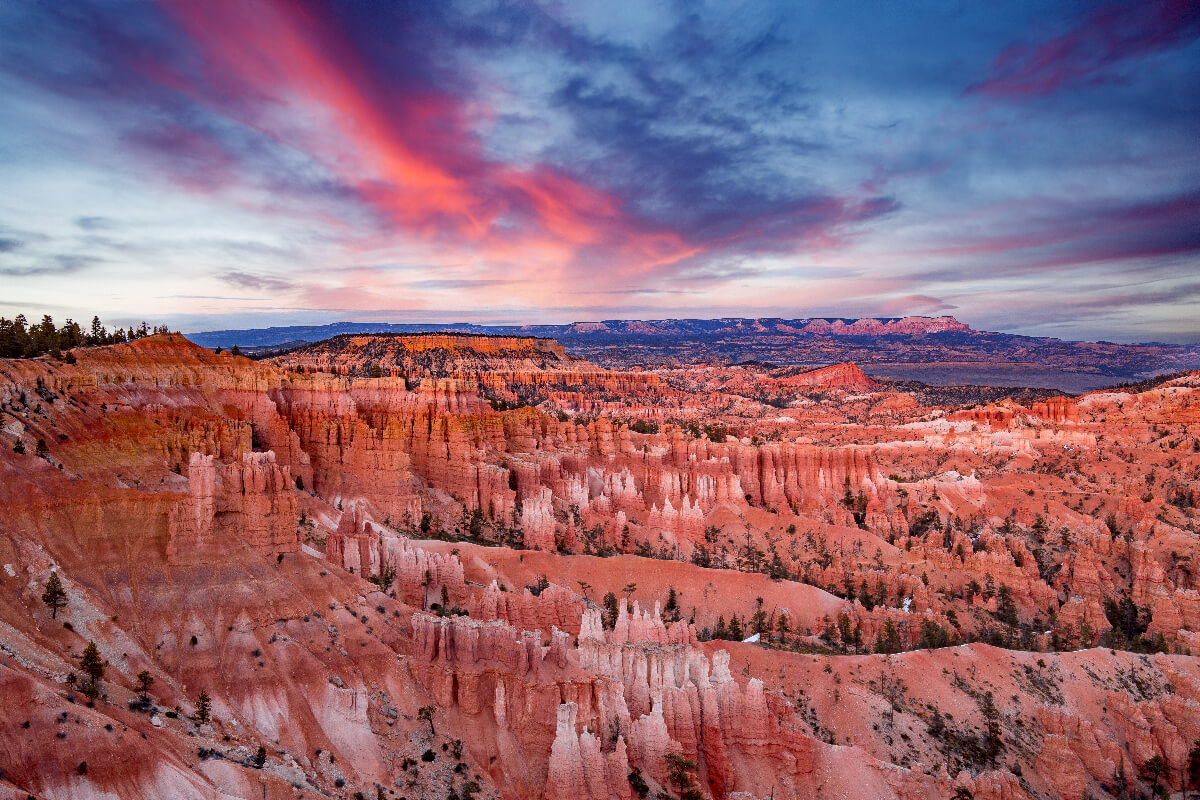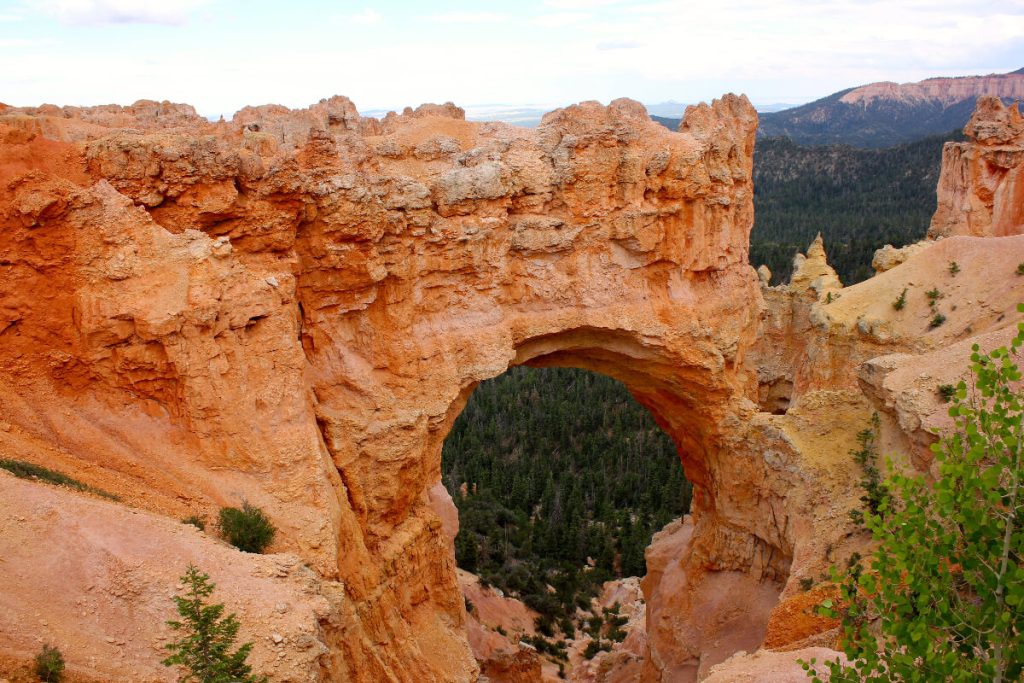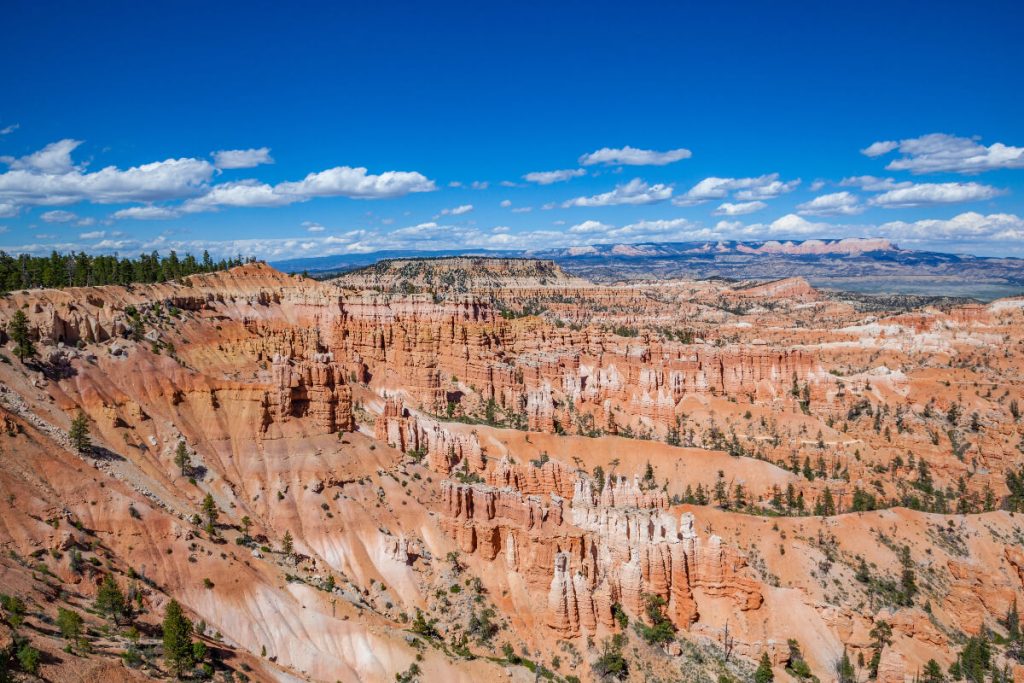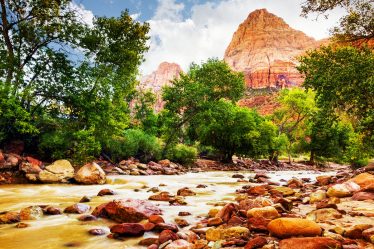
Welcome to the world of travel! Today, I invite you on a unique adventure in the heart of America, to a magical place with extraordinary geological formations and breathtaking colors. It is there, in Utah, where one of the most spectacular national parks of the United States is located – Bryce Canyon. In this article, we will take you on a virtual tour of this fascinating place, where every step is a discovery of new landscapes and experiences. Get ready for breathtaking views, unique geological history, and fascinating legends that surround this extraordinary national park. Are you ready for an adventure among impressive rock formations and unforgettable views? Let’s start our journey to the magical world of Bryce Canyon!
Location
Bryce Canyon is located in the southwestern part of Utah, in the United States. It is one of the five national parks in Utah, known for its unique landscape in the form of an „amphitheater” – a huge arena filled with hundreds of colorful, narrow rock spires, called „hoodoos” by locals. The park covers an area of about 145 km² and is located at an altitude of about 2,400 to 2,700 meters above sea level, making it one of the highest places in the United States. This extraordinary location of the park not only offers amazing views of the surrounding area but also creates unique climatic conditions that affect the unique flora and fauna of this area. This magical place attracts tourists from all over the world, ready to discover its beauty and secrets.
A Brief History
The history of Bryce Canyon dates back to prehistoric times when the area was inhabited by the Puebloan Indians, who left traces in the form of caves and villages. However, the first European discoverer of this area was a Mormon farmer named Ebenezer Bryce, who settled there in 1875. He built the first house and created his farm in what is now Bryce Canyon National Park.
Although Bryce Canyon was named after Ebenezer Bryce, he was not the creator of the famous „hoodoos” or rock formations that now attract tourists from all over the world. In fact, Bryce did not appreciate the beauty of this area, considering it a „hell’s hole,” which later gave the park its name – Bryce Canyon.
Initially, the park was only a protected area for local farmers and shepherds, and it was not until 1923 that it was recognized as a protected area and designated as a national park. Since then, the park has continuously developed and become a popular destination for tourists who come here to admire the extraordinary rock formations and natural beauty.
Today, Bryce Canyon is one of the most important national parks in the United States, attracting nature, geology, and history enthusiasts. It is a place where you can experience unique landscapes, immerse yourself in the fascinating history of the Puebloan Indians, and enjoy unforgettable adventures among the unique rock formations.
What to see?
Bryce Canyon is a national park full of remarkable places worth visiting. Here are some of the most important places to see in Bryce Canyon:
- Amphitheater – The main attraction of the park, a huge arena filled with hundreds of colorful „hoodoos,” narrow rock spires that are a characteristic element of the Bryce Canyon landscape. They can be admired from numerous viewpoints such as Sunrise Point, Sunset Point, and Inspiration Point.
- Navajo Loop Trail – One of the most popular trails in the park, which allows for a walk among fascinating rock formations. This picturesque trail leads down the canyon, passing attractions such as Thor’s Hammer or Wall Street, providing unforgettable experiences during the hike.
- Queen’s Garden – This area in the park is famous for its unique rock formations resembling sculptures, such as The Queen Victoria or The Queen’s Castle. It is one of the most beautiful places in Bryce Canyon, which amazes with its extraordinary charm.
- Bryce Point – One of the most picturesque places in the park, offering breathtaking views of the entire Bryce Canyon amphitheater. It is the perfect place to admire the sunrise or sunset, when it illuminates the „hoodoos” with golden and red hues.
- Natural Bridge – This impressive rock arch is one of the most famous viewpoints in the park. It is accessible on a short hiking trail and offers unforgettable views of the surrounding landscape.
- Rainbow Point – This is the southernmost point in the park, offering incredible views of the park’s panorama and surrounding mountains. It is a perfect place for stargazing at night or having a picnic in nature.
These are just a few of the many extraordinary places to discover in Bryce Canyon. The park also offers many other hiking trails, viewpoints, campgrounds, and attractions waiting to be discovered by adventure and nature enthusiasts.
If you want to read more about National Parks in USA see This.
The Amphitheater

The Amphitheater in Bryce Canyon is one of the main attractions of this national park. It is a huge amphitheater-shaped arena filled with hundreds of colorful „hoodoos„, narrow rock spires. These impressive rock formations, reaching up to 60 meters in height, are created by erosion processes and come in a variety of shapes and colors, such as red, orange, pink, white, and brown, creating a stunning landscape. The Amphitheater in Bryce Canyon offers spectacular views from numerous viewpoints, such as Sunrise Point, Sunset Point, and Inspiration Point, where you can admire these unique rock formations that change depending on the light and time of day. This magical place attracts tourists from all over the world, enchanting them with its extraordinary beauty and unforgettable views.
Navajo Loop Trail

Navajo Loop Trail is one of the most popular hiking trails in Bryce Canyon National Park. It is a spectacular trail leading down into the canyon, allowing you to discover fascinating rock formations and breathtaking views. This trail is about 1.3 km long and offers a unique hiking experience among the „hoodoos”, narrow rock spires that are a characteristic feature of Bryce Canyon’s landscape. Along the trail, you can admire attractions such as Thor’s Hammer – an impressive rock formation resembling Thor’s hammer, and Wall Street – a narrow path among the rock formations, creating unforgettable impressions. Navajo Loop Trail is one of the most scenic trails in the park, offering unforgettable views and an exciting experience in exploring the extraordinary rock formations of Bryce Canyon.
Queen’s Garden

Queen’s Garden is one of the most charming areas in Bryce Canyon National Park. It is a region located in the lower part of the canyon, known for its beautiful rock formations resembling gardens. Queen’s Garden is a picturesque area with a rich diversity of shapes and colors of rock formations, including unique „hoodoos” – narrow rock spires that are characteristic of the Bryce Canyon landscape. The Queen’s Garden Trail offers great opportunities to observe and photograph these unusual rock formations, including formations such as Queen Victoria – an impressive rock formation resembling Queen Victoria, and The Queen’s Garden – an area named after the „Queen’s Garden” and is one of the most picturesque places in the park. This magical place attracts tourists interested in the beauty of nature and geological wonders that can be admired in this area.
Bryce Point

Bryce Point is one of the most important viewpoints in Bryce Canyon National Park. It is a place that offers breathtaking views of the rock formations characteristic of this park. Located on the eastern edge of the park, Bryce Point offers panoramic views of the amphitheater and „hoodoos” – narrow rock spires that create an unusual landscape. Especially early in the morning or late in the evening, when the sunlight casts warm hues on the rock formations, Bryce Point becomes a magical place to observe the sunrise or moonrise. It is also an excellent place to photograph the unusual rock formations and enjoy the panorama of Bryce Canyon National Park. Bryce Point is easily accessible through trails and viewing platforms that allow tourists to enjoy unforgettable views of one of the most spectacular places in the park.
Natural Bridge

Natural Bridge in Bryce Canyon National Park is an impressive rock formation that is one of the most important geological landmarks in this region. It is a natural rock bridge that was formed as a result of erosion processes, where water and wind washed out the interior of the rock, creating an impressive arch-shaped structure. Natural Bridge is about 32 meters wide and 46 meters high, making it one of the largest natural bridges in the park. It is located in the amphitheater of Bryce Canyon and is accessible to tourists through a specially designated path, allowing observation and photography of this impressive rock formation up close. Natural Bridge is one of the unique geological treasures of Bryce Canyon National Park, attracting tourists interested in natural beauty and unusual rock formations.
Rainbow Point

Rainbow Point is the highest viewpoint in Bryce Canyon National Park, located at an elevation of approximately 2,775 meters above sea level. It offers stunning panoramic views of the park, surrounding mountains, and valleys. Rainbow Point marks the end of the Scenic Drive, a scenic road that winds through Bryce Canyon National Park, allowing tourists to admire the spectacular rock formations and natural beauty of the area. From Rainbow Point, visitors can enjoy views of various rock formations, such as „hoodoos,” narrow rock spires, as well as distant mountain peaks and vast valleys. Rainbow Point is easily accessible to tourists and offers various viewing platforms that allow for an unforgettable experience of the full beauty of Bryce Canyon National Park. It is one of the must-visit places to appreciate its natural beauty and breathtaking views.
Fun facts
Here are a few fun facts:
- Bryce Canyon is not a true canyon: Despite its name, Bryce Canyon is not a true canyon but a collection of natural amphitheaters in the form of „hoodoos” – tall, narrow rock spires in various shapes and colors.
- Colorful rock formations: The hoodoos in Bryce Canyon are known for their unusual colors. There are various shades of red, orange, yellow, and brown, creating a unique visual spectacle.
- The world’s largest collection of hoodoos: Bryce Canyon is considered to have the world’s largest collection of hoodoos. There are over 2,000 hoodoos in the park, making it an incredibly unique place.
- Dark skies: Bryce Canyon is also a popular spot for stargazing. The park has an International Dark Sky Reserve status, meaning it is an ideal location to observe stars, planets, meteors, and other cosmic phenomena.
- Diverse ecosystems: Despite its small size, Bryce Canyon has diverse ecosystems that vary depending on altitude and exposure. Visitors can see both pines and deciduous trees, as well as many species of plants and animals that have adapted to the harsh climatic conditions.
- Rich cultural history: The area of Bryce Canyon National Park is also rich in the cultural history of the Puebloan Indians, who inhabited the area about 12,000 years ago. The park contains numerous archaeological sites, including remnants of ancient villages and caves used by the Indians.
- Tourist attractions: The park offers many tourist attractions, such as viewpoints, hiking trails, pony rides, and mountain biking. Visitors can also participate in interpretive programs offered by the park, such as ranger presentations or guided tours.
These fun facts only scratch the surface of the unique and fascinating place that is Bryce Canyon. It is a place of unique rock formations, beautiful nature, and rich history, attracting tourists from all over the world.
When is the best time to visit Bryce Canyon?
The best time to visit Bryce Canyon National Park depends on the traveler’s preferences and the activities they want to do there. Each season has its advantages and disadvantages, offering different experiences and atmosphere. Here’s a brief summary of the best times to visit Bryce Canyon:
Spring (March-May): Spring is an excellent time to visit Bryce Canyon as the park comes alive after winter and the vegetation starts to bloom. Early spring, especially March, can be quieter and less crowded than later months, allowing for more peaceful sightseeing and avoiding tourist crowds. Temperatures are usually moderate, making it an ideal time for hiking in the park.
Summer (June-August): Summer is the most popular time to visit Bryce Canyon due to warmer temperatures and longer days. It’s a perfect time for hiking when most trails are accessible, and weather conditions are favorable. In summer, you can also participate in various interpretive programs offered by the park, such as ranger presentations or night hikes with flashlights.
Fall (September-November): Fall in Bryce Canyon is the time when the trees change colors to beautiful shades of red, orange, and gold, making the park a true visual spectacle. September and October are particularly popular due to the view of colorful rock formations against autumn leaves. It’s also a time when tourist crowds start to decrease, allowing for more peaceful sightseeing in the park.
Winter (December-February): Winter in Bryce Canyon is when the park turns into a winter wonderland with snow-covered rock formations and a quiet, peaceful environment. Although some trails and viewpoints may be closed due to weather conditions, you can participate in snowshoe hikes, cross-country skiing, or enjoy the winter view of the park from the overlooks.
In summary, Bryce Canyon can be visited all year round, and each season has its charms. It’s worth visiting and admiring the beauty of nature in the USA.



